Nutter's Platt
Categories: uncategorized
Tags: urbanwalks, upnorth
Date: 14 February 2009 03:26:21
Friday's intention was to walk south out of Lower Penwortham (the other side of the river Ribble from Preston) to Longton or Lostock Hall or maybe Leyland (where the cars came from). Perhaps even to Chorley (though that might have wanted a bus back). But I woke up too late. And then I fell asleep again. And it was the afternoon and late and dinner was going to be cooked and there wasn't much walking time.
But I'd been indoors (except for a brief visit to the pub on Thursday) so a walk was needed so I went down the mysterious path beside the Methodist church to see where it went.
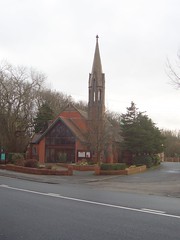 | 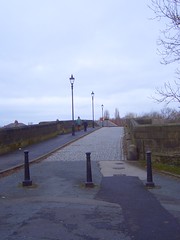 |  |
And it is a little mysterious because its dead straight and connects with other paths (as paths usually do because they are so often older than the buildings around them) and many of those paths in that district are old tramways or torn-up rails but the north end of this path crosses the road and hits the river in a dead straight line just about ten metres from the old bridge at Preston Riverside - right by the Bridge Inn - and at an angle that looks far too sharp for any tram to turn. And that bridge doesn't look at all like a tram bridge, its older and cobbled. So what was the path before?
[Commenting on my own post I was an idiot when I wrote that. There is a ruined tram bridge right beside the old bridge. I have known it was there for nearly twenty years:]
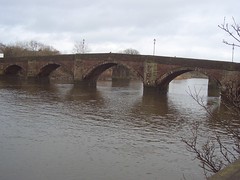 |  |
[On the other hand the old bridge at Penwortham is pretty wonderful. And once upon a time it would have been the main north-south road west of the Pennines. No wonder 18th-century armies had trouble moving around]
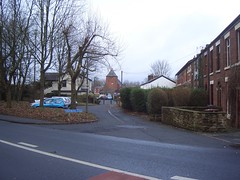 | 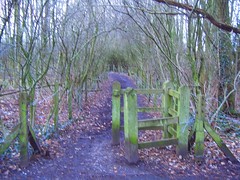 |
Anyway, up the path through or past playing fields and onto a bridge over the new dual carriageway (Penwortham Bypass?) and through some suburban estates mainly (as far as I can tell) occupied by overmadeup teenage girls who shout at boys on bicycles "Stewart! I saw you at school this afternoon!"
Penwortham is what I think of as a classic suburb. Which is a term I made up myself when walking round London and I am sure there are all sorts of geographers and town planners and people who have different names for it. Its basically residential, but quite high density. There are little clusters of small shops and public buildings here and there at road junctions. Perhaps they are the remnants of pre-existing villages, or little 1960s shopping centres or maybe they just mark some shop opened by an enterprising woman in the days before planning permission. There's one where Cop Lane meets Pope Lane in Penwortham, with the Black Bull pub (which an old man told me was the oldest in the Preston area, which seems unlikely), a launderette, a fake tan shop (do people really pay to be dyed orange?), an Italian takeaway called "Puccini's" (with pictures of the great man himself on the walls) and some sort of school.
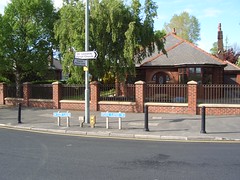 | 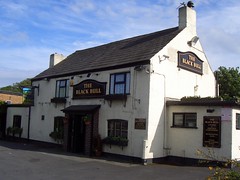 |
These places are different from high-density inner suburbs which have a natural network of streets with ribbon-developments or corner shops or small businesses that bind them together (except where post-1945 ideas of planning have allowed the local council to destroy the network with big blocks) Though the road leading through Lower Penwortham from the old bridge towards Pope Lane (Leyland Road or Penwortham Lane) has enough buildings that look as if they used to be shops to give me the feeling that it was once one of those stretched-out natural shopping ribbons - as the housing there is late 19th or more likely very early 20th century (you can tell by residential street names - Gaskell, Buller, Stanley - later twentieth century town councillors short of a name for rapidly might have named a street in some Poet's Corner for Elizabeth Gaskell and maybe even Henry Morton Stanley (though unlike her he didn't deserve it) but hardly Redvers Buller) it looks more like an extension of the higher density more urban or inner-suburban building over he river from Preston than it does any autonomous growth of Penwortham.
They are also different from outer suburbs which are too low-density for walking to the shops so have commercial centres you have to drive to. Though that is the visual image most people have when they thin of "suburb". These "classic suburbs" are the creation of the bus, the tram, and local councils. And with buses rare and trams extinct and councils powerless they are now not what they used to be. Almost anyone will walk a quarter of a mile to a corner shop or a church or a pub or a primary school. Not that many people will walk a mile to get to them if they have a car instead. And once they get in the car they are off out of their locality to wherever.
Why Pope Lane? Is it some survival of Lancashire catholicism? Or just named after some bloke called Pope?
There is a kind of suburban house here that I've not seen many of in London (though there are some in Worthing and in the outskirts of Ipswich - why does "outskirts of Ipswich" sound like a Middle English poem?) Low-rise, often just single-story, more or less filling their plot. Small gardens - too much at the front, not enough at the back - one or more likely two garages built into the house (do they call them "car ports?") approached by a little drive that is the only obvious way in - there seems to be no separate pedestrian access as if no-one is expected to arrive on foot. Big ornate gates that often look as if they are operated electrically and have pillars with classical style bits of garden-centre sculpture on them. Huge hedges or fences often only a metre or two in front of the windows. I imagine they are lovely inside, but from outside they look like houses I would hate.
If you walk to the end of Pope Lane you get to Nutter's Platt. As far as I can tell the name is more interesting than the place. It seems to be a large lorry-ridden roundabout where some 1960s dual carriageways meet. With fields on one side - real fields with crops in them - and a little suburb called Kingsfold on the other. I don't think its the Kingsfold the hymn tune was named after.
I turned left walked along the side of the road (The A582 to Leyland) for a little well but it was getting dark (I said I got up late) and the road was noisy and smelly and full of cars driving home so I cut into the first footpath I found and jumped over a stile and over a muddy field. Yhere is a lot of mud round there. On the map many of the fields are called this-that-or-the-other "Moss" and the little burns or streams or ditches are called "gutters". Which is a clue to the nature of the ground. I was glad I was wearing my boots.
More of those houses on Bee Lane. On the map the houses round here are called this-that-and-the-other "farm". But they are not farms any more. They are suburban houses and the residents are driving back from work. I pass a few walking from their cars to their doors. "Alright?" they say, in an uncommittal Lancashire way.
I heard a bird calling. Again and again and again. I'd love to be able to recognise birds by their calls. I'm crap at it. I guess that goes along with not being able to sing myself. Often I've had to relearn the songs of bird like garden warblers and blackcaps and willow warblers in the summer, because I've forgotten them from the year before. Each year its new. This wasn't a warbler. (Not in February in Lancashire after dark) Maybe it was a short-eared owl. I want it to have been a short-eared owl. But for all I know it could have been some sort of plover.
There was one place that looked like a real farm. A yong woman was walking out of it into some kind of concrete outhouse. A little dog in a coat dashed out and barked at me. The woman yelled at the dog and apologised to me. I said it was alright and walked on. You always walk on when a dog goes for you, even if its a little one. As I walked away I could here another, older woman talking to her. "What was that all about?" She sounded cross.
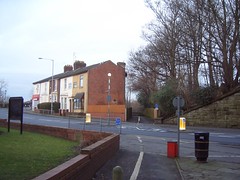 | 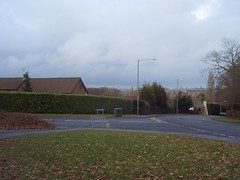 |
Down into Park Lane in Penwortham and I see a church spire in the near dark. It looks huge. I mean really huge, the biggest thing for miles. None of the Penwortham churches can be that big? The tower is is taller than any building near it, and the spire on top of the tower a lot taller than that. Of course it isn't one of the Penwortham churches, it is St Walburge's, a Roman Catholic church in Preston on the sother side of the river well over a mile away. Famously one of the tallest spires in England. It doesn't look that big when you are near it.
Overheard in the pub that night: "I hate being called a 'milf'. Even my fifteen-year-old daughter said it. I don't know where she got it from" A conversation interuppted by the arrival of a young woman who for all I know could have been the fifteen-year-old daughter. I think that might be the first time I have ever heard the word "milf" spoken. I only know it from webpages.
Later on in the same pub, landlord to distressed young barmaid: "get some water in a glass and throw it on it!". I found out later that there had been a fire in a bin outside where customers smoke. The landlord seemed neither suprised nor worried.